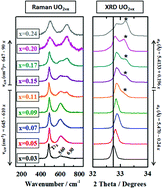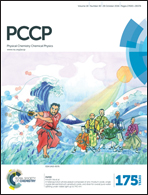A detailed Raman and X-ray study of UO2+x oxides and related structure transitions
Abstract
This work presents a detailed study of hyperstoichiometric UO2+x (0 < x < 0.25) oxides and an assessment of the structural evolution taking place as oxidation proceeds. For this purpose, different UO2+x powder samples with controlled degree of non-stoichiometry have been identified by thermogravimetric analysis and characterized by X-ray diffraction (XRD) and Raman spectroscopy. XRD analysis reflects that the commonly assumed Vegard's law is not applicable over the whole hyperstoichiometry range, since a slight increase of the lattice constant is observed for 0.13 < x < 0.20. A quantitative Raman analysis of the UO2+x spectra as a function of the oxidation degree is also shown. A new method to characterize any UO2+x sample (for x < 0.20), based on the shift of the 630 cm−1 band observed in the Raman spectrum, is proposed here for the first time. Moreover, three structure transitions have been detected at x = 0.05, 0.11 and 0.20, giving rise to four distinct regions associated with consecutive structural rearrangements over the hyperstoichiometry range: x < 0.05, 0.05 < x < 0.11, 0.11 < x < 0.20 and 0.20 < x < 0.25.



 Please wait while we load your content...
Please wait while we load your content...